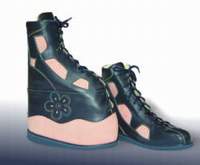Orthopedic shoes are gonna walk all over you
These shoes are made for walking

Do you happen to believe that orthopedic shoes are designed for the handicapped? On the contrary, orthopedic shoes are specifically made for the prevention of deformities that may affect the terminal organ of your lower extremities.
You should definitely opt to wear orthopedic shoes if you fall under the following categories:
- You are overweight;
- You are pregnant, and your feet tend to swell up and tire out as your body becomes heavier;
- You spend a lot of time walking or standing because of your profession;
- You are affected with flatfoot;
- You have a heel bone’s spur or salt deposits that cause painful sensations during walking;
- Calluses or thickened parts of the skin on your feet make your walking an unpleasant experience;
- The soles of your feet are of a diabetic type i.e. they are not very sensitive to mechanical damage.
Besides, orthopedic shoes can come in handy for the correct sole formation in infancy, and as a means to lessen age-related discomfort for the elderly. By and large, doctors believe every healthy individual should wear good shoes with orthopedic components from time to time for the benefit of the feet.
On the whole, our feet are hard to look at with envy. Sometimes women run despite wearing stiletto shoes, they wear uncomfortable shoes, and carry heavy bags. Consequently, their feet tire out fast, develop calluses and swellings. And every other one has a “non-standard foot” e.g. the high arch of a foot, a flat foot or wide foot. As for the prevention of discomfort and painful sensations associated with daily walking, orthopedic shoes are strongly recommended in the above cases.
There is a variety of orthopedic shoes depending on the purpose of their use. They can be used either for moving lighter on your feet or correcting joints or a posture.
Extra wide orthopedic shoes can help overweight persons and pregnant women to fight the swelling of their feet. The wide shoes are wider than the standard-width shoes. Thanks to extra width, the load is spread over the entire sole of the foot in a most agreeable way. The foot in such a shoe will not feel tired even after a few hours of walking. The shoes are made of elastic materials and equipped with numerous straps and laces so that the wearer may loosen them a little in the evening. The shoes normally rest on a low and steady sole made of elastic materials, which can make your step lighter as you “push away” from the hard surface.
A wide range of orthopedic insoles can be used for a variety of purposes. The insole can be either part of a shoe design or marketed as a separate item. Orthopedic insoles are made of real leather, cork, latex etc.
Anatomically molded insoles are particularly good for those affected by all kinds of flatfoot. The shape of an insole makes the sole of the foot assume the right position. It can provide excellent support to the arch of the foot and helps reduce tension in muscles and ligaments. As a result, the feet do not tire out too fast, blood circulation in the muscles gets back to normal, and swellings start to disappear. Anybody can wear such shoes in the home or for prevention purposes.
A pair of fine shoes often comes with anatomically molded insoles – a kind of guarantee of long and enjoyable use of the shoes.
Special orthopedic insoles or inlays can be either ready-made or custom-built. They help spread the load over the entire sole of the foot affected by heel bone’s spurs, calluses, bumps and other deformities. The insoles can be made especially for the heels, toes or entire soles of the feet. Moreover, they are shaped to order after a cast molded for each foot. Needless to say, you will have to visit a special shoe store or workshop to purchase or order such articles.
Heavy-duty shoes are made for those who spend a great deal of time standing or walking because of their profession. According to usage instructions, such shoes “provide support and brace comfort, and spread the static and dynamic load over the sole of the foot for the purpose of prevention of diseases affecting lower extremities.” In other words, the shoes are comfortable and good at holding the ankle and sole in the right position. They are also highly breathable. Manufactures normally use materials with good absorbing properties e.g. cork, soft porous leather. The shoes are great for wearing in the street and the home alike.
Orthopedic shoes for “bony feet” are an aid to make one’s life easier. They have fancy openings (or patches of elastic fabric) for relieving tension buildup on the aching joints.
Massage shoes are usually shaped like sandals or sling-back shoes. They are low-cut in front, and have a special cylinder pad to fit under the toes. The wearer has to apply some force to the toes in order to hold his shoe in place while walking. As a result, the exercise also has a beneficial effect on the sole of the foot as a whole. The muscles get trained, blood circulation gets better, and the walls of the blood vessels get stronger. However, you will hardly use such shoes for walking long distances. On the other hand, they are second to none when worn in the home.
Medportal
Translated by Guerman Grachev
Pravda.Ru
Subscribe to Pravda.Ru Telegram channel, Facebook, RSS!


